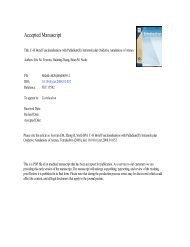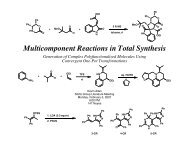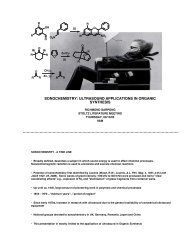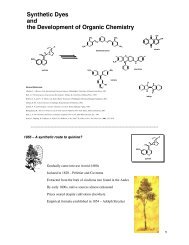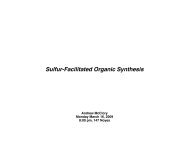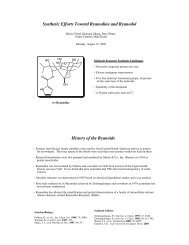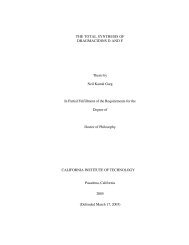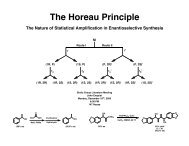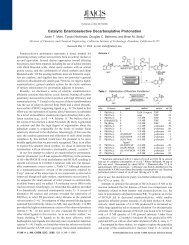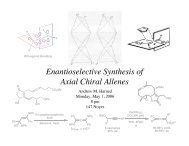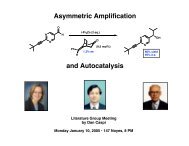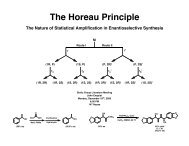Catalytic Olefin Hydroboration: Mechanistic ... - The Stoltz Group
Catalytic Olefin Hydroboration: Mechanistic ... - The Stoltz Group
Catalytic Olefin Hydroboration: Mechanistic ... - The Stoltz Group
Create successful ePaper yourself
Turn your PDF publications into a flip-book with our unique Google optimized e-Paper software.
CO 2 RCH 2 OHAr CH 3Ar CH 3<strong>Catalytic</strong> <strong>Olefin</strong> <strong>Hydroboration</strong><strong>Mechanistic</strong> Features, Practical Considerations and Synthetic ApplicationsArB(OR) 2Ar CH 3OHAr CH 3Alexander Goldberg<strong>Stoltz</strong> <strong>Group</strong> Literature PresentationMarch 1, 20108 PM, 147 NoyesAr'NHRNH 2Ar CH 3Ar CH 3Ar CH 3
Introduction to <strong>Hydroboration</strong>HRHRHHH HBH R3H BHB2R HHH[O]ROH• Convenient method for anti-Markovnikoff hydration of olefinsRMechanism:H BR 2H HHRHHRHδ+δ-BR 2HH BR 2H HR H• Asynchronous transition state: partial charge buildup• Substituent most capable of stabilizing partial positive charge receives protonFirst Publication: Brown, H. C. J. Am. Chem. Soc. 1956, 78, 5694–5695.Review: Brown, H. C. Org. React. 1963, 13, 1–54.
Stoichiometric Enantioselective <strong>Hydroboration</strong>BH 3 •THF2BH0 °Cα-pinene( + or – )92% eeIpc 2 BH> 99% eeDiisopinocampheylborane (Ipc 2 BH)HOHO98% ee92% ee• Allowing Ipc 2 BH to stand @ 0 °C• in presence of slight excess of• α-pinene gives enantiopure• reagentHO93% ee• "<strong>The</strong> first truly successful,• nonenzymatic, asymmetric• synthesis"HO83% eeFirst Publication: Brown, H. C. J. Am. Chem. Soc. 1961, 83, 486–487.Review: Brown, H. C. Acc. Chem. Res. 1988, 21, 287–293.
Late Transition Metal CatalysisOBCatHBCatOHBCatOHCatBHRhCl(PPh 3 ) 3HBCat =HBCatNo catalyst:100 °C, 2 h, 90% yieldHBCat0.05 mol% RhCl(PPh 3 ) 320 °C, 20 min, 83% yield• ~4:1 selectivity for olefin in presence of ketone with Wilkinson's catalyst• Temperature & Reaction time greatly reduced for catalyzed variant• No noticeable rate difference for BH 3• Catecholborane is much less lewis acidic than borane:• slower uncatalyzed hydroborationOBHOcatecholboraneCatecholborane: Brown, H. C. J. Am. Chem. Soc. 1971, 93, 1816–1818Catalyzed: Nöth, H. Angew. Chem. Int. Ed. Engl. 1985, 24, 878–879.
Initial Proposed MechanismRhL 3 ClCatBH-LHBCatRhL 2 ClHCatBRhClLLCatBHRhClLLCH 2CH 2+LH-LCatBRhClL• Supported by catalytic viability of catecholborane adduct• Loose ends: reversibility of each step?• Boryl v. Hydride insertion?Nöth, H. Angew. Chem. Int. Ed. Engl. 1985, 24, 878–879.
Deuterium Labelling Studiesn-OctDBCat (0.1 equiv)RhCl(PPh 3 ) 3 (0.2 mol%)28%33%HOn-Oct+n-Oct5%33%Deuterium distributionEvans, D. A. J. Am. Chem. Soc. 1992, 114, 6679–6685.
Deuterium Labelling Studiesn-OctDBCat (0.1 equiv)RhCl(PPh 3 ) 3 (0.2 mol%)28%33%HOn-Oct+n-Oct5%33%Deuterium distributionn-Octn-OctDn-OctDn-Octn-OctDn-Octn-OctBHRh Dβ-Helim.Dn-OctBDRhhydridemigrationDβ-Helim.n-OctBHRhDn-OctHDRhBBRhBRhBRhXreductiveeliminationXHDBDDn-Octn-Octn-OctDn-OctBBBEvans, D. A. J. Am. Chem. Soc. 1992, 114, 6679–6685.
Deuterium Labelling StudiesDDBCat (0.1 equiv)HOn-OctRhCl(PPh 3 ) 3 (0.2 mol%)5%28%n-Oct+33%33%n-Octn-Octn-OctDn-OctDn-Octn-OctDn-Octn-OctBHRh Dβ-Helim.Dn-OctBDRhhydridemigrationDβ-Helim.n-OctBHRhDn-OctHDRhBBRhBRhBRhXreductiveeliminationXHDBDDn-Octn-Octn-OctDn-OctBBBEvans, D. A. J. Am. Chem. Soc. 1992, 114, 6679–6685.
Deuterium Labelling StudiesDBCat (0.1 equiv)28%HOn-Octn-Oct+RhCl(PPh 3 ) 3 (0.2 mol%)5%D 33%n-Oct33%n-Octn-OctDn-OctDn-Octn-OctDn-Octn-OctBHRh Dβ-Helim.Dn-OctBDRhhydridemigrationDβ-Helim.n-OctBHRhDn-OctHDRhBBRhBRhBRhXreductiveeliminationXHDBDDn-Octn-Octn-OctDn-OctBBBEvans, D. A. J. Am. Chem. Soc. 1992, 114, 6679–6685.
Deuterium Labelling Studiesn-OctDBCat (0.1 equiv)RhCl(PPh 3 ) 3 (0.2 mol%)28%HOn-Oct5%+33%n-OctD 33%n-Octn-OctDn-OctDn-Octn-OctDn-Octn-OctBHRh Dβ-Helim.Dn-OctBDRhhydridemigrationDβ-Helim.n-OctBHRhDn-OctHDRhBBRhBRhBRhXreductiveeliminationXHDBDDn-Octn-Octn-OctDn-OctBBBEvans, D. A. J. Am. Chem. Soc. 1992, 114, 6679–6685.
Deuterium Labelling Studiesn-OctDBCat (0.1 equiv)RhCl(PPh 3 ) 3 (0.2 mol%)28%HOn-Oct5%D+33%33%n-Octn-Octn-OctDn-OctDn-Octn-OctDn-Octn-OctBHRh Dβ-Helim.Dn-OctBDRhhydridemigrationDβ-Helim.n-OctBHRhDn-OctHDRhBBRhBRhBRhXreductiveeliminationXHDBDDn-Octn-Octn-OctDn-OctBBBEvans, D. A. J. Am. Chem. Soc. 1992, 114, 6679–6685.
Deuterium Labelling Studiesn-OctDBCat (0.1 equiv)RhCl(PPh 3 ) 3 (0.2 mol%)28%33%HOn-Oct+n-Oct5%33%Deuterium distributionβ-Hydride elimination to form olefins is fastern-Octn-OctD n-Octthan reductive elimination at a secondary carbonDn-Octn-OctDn-Octn-OctBHRh Dβ-Helim.Dn-OctBDRhhydridemigrationDβ-Helim.n-OctBHRhDn-OctHDRhBBRhBRhBRhXreductiveeliminationXHDBDn-Octnot observedn-OctDn-OctBBEvans, D. A. J. Am. Chem. Soc. 1992, 114, 6679–6685.
Internal v. Terminal <strong>Olefin</strong> IsomersHBCatCatalyst (2.5 mol%)OHproduct ratios+3-ol + 2-ol + 1-olRhCl(PPh 3 ) 3100– – –[Rh(nbd)(dppb)]BF 4 87 7 2 4nbd = dppb =Ph 2 PPPh 2• Generation of an internal olefin complex: less facile than reductive elimination?CatB HRhHRHβ-hydrideeliminationCatBRCatBreductiveRhRheliminationBCatH vs.R'R'RRH H H H H Hβ-Hydride elimination to form olefins is fasterthan reductive elimination at a secondary carbonEvans, D. A. J. Am. Chem. Soc. 1992, 114, 6679–6685.
Internal v. Terminal <strong>Olefin</strong> IsomersHBCatCatalyst (2.5 mol%)OHproduct ratios+3-ol + 2-ol + 1-olRhCl(PPh 3 ) 3100– – –[Rh(nbd)(dppb)]BF 4 87 7 2 4nbd = dppb =Ph 2 PPPh 2• Generation of an internal olefin complex: less facile than reductive elimination?• Examine a system which has access to both internal and terminal olefin complexesn-pentHBCat[Rh(nbd)(dppb)]BF 4 (2.5 mol%)n-pent +n-pent+B B B12% 20% 68%n-pentproduct ratiosβ-Hydride elimination to form terminal olefins is fasterthan reductive elimination at a secondary carbonEvans, D. A. J. Am. Chem. Soc. 1992, 114, 6679–6685.
Internal v. Terminal <strong>Olefin</strong> Isomersn-Bun-pentn-PentHRhBRhHBHRhBβ-Helim.hydrideinsertionβ-Helim.n-pentn-pentn-pentB Rh B Rh B Rhn-pentHBCat[Rh(nbd)(dppb)]BF 4 (2.5 mol%)n-pent +n-pent+B B B12 20 68product ratiosn-pentβ-Hydride elimination to form terminal olefins is fasterthan reductive elimination at a secondary carbonEvans, D. A. J. Am. Chem. Soc. 1992, 114, 6679–6685.
Internal v. Terminal <strong>Olefin</strong> Isomers• β-hydride elimination from 1• gives internal olefin in either directionn-Bun-pentn-PentHRhBRhHBHRhBβ-Helim.hydrideinsertionβ-Helim.BRhn-pent1BRhn-pentBRhn-pentn-pentHBCat[Rh(nbd)(dppb)]BF 4 (2.5 mol%)n-pent +n-pent+B B B12 20 68product ratiosn-pentβ-Hydride elimination to form terminal olefins is fasterthan reductive elimination at a secondary carbonEvans, D. A. J. Am. Chem. Soc. 1992, 114, 6679–6685.
Internal v. Terminal <strong>Olefin</strong> Isomers• β-hydride elimination from 1• gives internal olefin in either direction• Intermediate 2 will undergo β-hydride• elimination in preference to reductive• eliminationHRhn-BuBβ-Helim.HhydrideinsertionRhn-pentBβ-Helim.HRhBn-Pent• Similar to 1-octene case!n-pentn-pent1 2 3B Rh B Rh B Rhn-pentn-pentHBCat[Rh(nbd)(dppb)]BF 4 (2.5 mol%)n-pent +n-pent+B B B12 20 68product ratiosn-pentβ-Hydride elimination to form terminal olefins is fasterthan reductive elimination at a secondary carbonEvans, D. A. J. Am. Chem. Soc. 1992, 114, 6679–6685.
Aryl substituents – Regioselectivity Inverted!OHDBCat (0.1 equiv)DRhCl(PPh 3 ) 3Only deuterium-containing product!β-Hydride elimination to form terminal olefins is fasterthan reductive elimination at an aliphatic secondary carbonEvans, D. A. J. Am. Chem. Soc. 1992, 114, 6679–6685.
Aryl substituents – Regioselectivity Inverted!OHDBCat (0.1 equiv)DRhCl(PPh 3 ) 3Only deuterium-containing product!DRhBRh B BDD• Either the insertion or complexation must be irreversible• hydride (deuteride) migration only occurs in one directionβ-Hydride elimination to form terminal olefins is fasterthan reductive elimination at an aliphatic secondary carbonEvans, D. A. J. Am. Chem. Soc. 1992, 114, 6679–6685.
Aryl substituents – Regioselectivity Inverted!OHDBCat (0.1 equiv)DRhCl(PPh 3 ) 3Only deuterium-containing product!DRhBRh B BDD• Either the insertion or complexation must be irreversible• hydride (deuteride) migration only occurs in one directionRhBR 3 P PR 3 CpRhRhPR 3PhDproposedobservedobservedπ-benzylic interaction: proposed stabilizing effectβ-Hydride elimination to form terminal olefins is fasterthan reductive elimination at an aliphatic secondary carbonEvidence for π-benzyl interaction, see (inc. refs) in:Hayashi, T. J. Am. Chem. Soc. 1989, 111, 3426–3428.Crudden, C. M. Angew. Chem. Int. Ed. 2007, 46, 7799–7802Evans, D. A. J. Am. Chem. Soc. 1992, 114, 6679–6685.
Technical Challenges - Catalyst OxidationOHHBCatOH+RhCl(PPh 3 ) 3branched (B)linear (L)mol ratioReference styrene HBCat a catalyst B:LEvans 10 1 0.02 >99:1(a) 1 2 0.02 86:4(b) 10 1 0.02 20:80(c) 1 1.1 0.01 10:90a DBCat used in Evans, ref (a)(a) Dai, L. J. Org. Chem. 1991, 56, 1670–1672.(b) Burgess, K. J. Org. Chem. 1991, 56, 2949–2951(c) Hayashi, T. Tetrahedron: Asymmetry 1991, 2, 601–612Evans, D. A. J. Am. Chem. Soc. 1992, 114, 6679–6685.
Technical Challenges - Catalyst OxidationOHHBCatOH+RhCl(PPh 3 ) 3branched (B)linear (L)mol ratioReference styrene HBCat a catalyst B:LEvans 10 1 0.02 >99:1(a) 1 2 0.02 86:4(b) 10 1 0.02 20:80(c) 1 1.1 0.01 10:90a DBCat used in Evans, ref (a)catalyst yield (%) B:LRh(PPh 3 ) 3 Cl 80 >99:1Rh(PPh 3 ) 3 Cl, O 2 treated 85 60:40[Rh(COD)Cl] 290 98:245 20:80[Rh(COD)Cl] 2 , 2 PPh 3 67 60:40[Rh(COD)Cl] 2 , 4 PPh 3Rh(PPh 3 ) 3 Cl, O 2 treated 85 99:1then 2 PPh 3• Freshly Prepared Wilkinson's catalyst vs. old or• even Commercially Available Wilkinson's catalyst react differently!• May restore regioselectivity by addition of triphenylphosphine(a) Dai, L. J. Org. Chem. 1991, 56, 1670–1672.(b) Burgess, K. J. Org. Chem. 1991, 56, 2949–2951(c) Hayashi, T. Tetrahedron: Asymmetry 1991, 2, 601–612Evans, D. A. J. Am. Chem. Soc. 1992, 114, 6679–6685.
Technical Challenges - Impure Reagentsn-OctylDBCat (0.1 equiv)Rh(PPh 3 ) 3 ClHO(β)(α)n-Octyl(β)(α)n-OctylRRA B Ccatalyst% D distributionA (α:β) B (α:β)B:CRh(PPh 3 ) 3 Cl (Evans) 67 33(11:89) (46:54)≥95:5Rh(PPh 3 ) 3 Cl (Burgess) * * ≤5:95* D label found in all possible C-D positions.Burgess, K. J. Org. Chem. 1991, 56, 2949–2951.Evans, D. A. J. Am. Chem. Soc. 1992, 114, 6679–6685.
Technical Challenges - Impure Reagentsn-OctylDBCat (0.1 equiv)Rh(PPh 3 ) 3 ClHO(β)(α)n-Octyl(β)(α)n-OctylRRA B Ccatalyst% D distributionA (α:β) B (α:β)B:CRh(PPh 3 ) 3 Cl (Evans) 67 33(11:89) (46:54)≥95:5Rh(PPh 3 ) 3 Cl (Burgess) * * ≤5:95Rh(PPh 3 ) 3 ClO 2 treatedRh(PPh 3 )Clundistilled olefin74 26 15:85(16:84) –5:≥95Rh(PPh 3 ) 3 Cl3% t-BuO 2 H79(11:89)21(50:50)70:30Rh(PPh 3 ) 3 Cl62O 2 treated, 2PPh 3 (11:89)38(44:56)≥95:5* D label found in all possible C-D positions.Burgess, K. J. Org. Chem. 1991, 56, 2949–2951.Evans, D. A. J. Am. Chem. Soc. 1992, 114, 6679–6685.
Technical Challenges - Impure Reagentsn-OctylDBCat (0.1 equiv)Rh(PPh 3 ) 3 ClHO(β)(α)n-Octyl(β)(α)n-OctylRRA B Ccatalyst% D distributionA (α:β) B (α:β)B:C• Vast discrepancies between Burgess• and Evans dataRh(PPh 3 ) 3 Cl (Evans) 67 33 ≥95:5(11:89) (46:54)Rh(PPh 3 ) 3 Cl (Burgess) * * ≤5:95• Fresh Wilkinson's cat. necessary,• as well as purified starting materialsRh(PPh 3 ) 3 ClO 2 treatedRh(PPh 3 )Clundistilled olefinRh(PPh 3 ) 3 Cl3% t-BuO 2 H74 26 15:85(16:84) –5:≥9579(11:89)21(50:50)70:30PURIFY YOURSTARTING MATERIALS!BE MINDFUL OF YOURCATALYST SOURCE!Rh(PPh 3 ) 3 Cl62O 2 treated, 2PPh 3 (11:89)38(44:56)≥95:5* D label found in all possible C-D positions.Burgess, K. J. Org. Chem. 1991, 56, 2949–2951.Evans, D. A. J. Am. Chem. Soc. 1992, 114, 6679–6685.
1,1-Disubstitution: Raising even more questions!OTBSOTBSDBCat (0.1 equiv)14%CH 3HO 86% CH 3Rh(PPh 3 )ClCH 3 CH 3RDRD distributionCH 3CH 3XRDRBDCHRh 3hydridemigrationβ-Helim.BHCHRh 3hydridemigrationDBRhHRRDRBRhCH 3DCH 3BRhCH 3reductiveeliminationXreductiveeliminationDBHRRDRBCH 3DCH 3BCH 3Evans, D. A. J. Org. Chem. 1990, 55, 2280–2282.Evans, D. A. J. Am. Chem. Soc. 1992, 114, 6679–6685.
1,1-Disubstitution: Raising even more questions!OTBSOTBSDBCat (0.1 equiv)14%CH 3HO 86% CH 3Rh(PPh 3 )ClCH 3 CH 3RDRD distributionCH 3CH 3XRDRBDCHRh 3hydridemigrationβ-Helim.BHCHRh 3hydridemigrationDBRhHRRDRBRhCH 3DCH 3BRhCH 3reductiveeliminationXreductiveeliminationDBHRRDRBCH 3DCH 3BCH 3Burgess, K. J. Org. Chem. 1991, 56, 2949–2951.Evans, D. A. J. Am. Chem. Soc. 1992, 114, 6679–6685.
1,1-Disubstitution: Raising even more questions!OTBSOTBSDBCat (0.1 equiv)14%CH 3HO 86% CH 3Rh(PPh 3 )ClCH 3 CH 3RDRD distributionCH 3XCH 3• Not surprising that tertiary product not• observedRDRBDCHRh 3hydridemigrationβ-Helim.BHCHRh 3hydridemigrationDBRhHRRDRBRhCH 3DCH 3BRhCH 3reductiveeliminationXreductiveeliminationDBHRRDRBCH 3DCH 3BCH 3Evans, D. A. J. Org. Chem. 1990, 55, 2280–2282.Evans, D. A. J. Am. Chem. Soc. 1992, 114, 6679–6685.
1,1-Disubstitution: Raising even more questions!OTBSOTBSDBCat (0.1 equiv)14%CH 3HO 86% CH 3Rh(PPh 3 )ClCH 3 CH 3RDRD distributionCH 3XCH 3• Not surprising that tertiary product not• observedRDR• Why is there no D at other methyl?BDCHRh 3hydridemigrationβ-Helim.BHCHRh 3hydridemigrationDBRhHBRhRCH 3DH 2 CRCH 3DBRhRCH 3reductiveeliminationXreductiveeliminationDBHRRDRBCH 3DCH 3BCH 3Evans, D. A. J. Org. Chem. 1990, 55, 2280–2282.Evans, D. A. J. Am. Chem. Soc. 1992, 114, 6679–6685.
1,1-Disubstitution: Raising even more questions!OTBSOTBSDBCat (0.1 equiv)14%CH 3HO 86% CH 3Rh(PPh 3 )ClCH 3 CH 3RDRD distributionCH 3XCH 3• Not surprising that tertiary product not• observedRDR• Why is there no D at other methyl?BDCHRh 3hydridemigrationβ-Helim.BHCHRh 3hydridemigration• Evans: diastereotopic preference:OTBSBRhDRCH 3reductiveeliminationBDH 2 CXRhRCH 3reductiveeliminationDBHRCH 3RhDH 2 C CH 3HMe[Rh]DBHRRDRBCH 3DCH 3BCH 3Evans, D. A. J. Org. Chem. 1990, 55, 2280–2282.Evans, D. A. J. Am. Chem. Soc. 1992, 114, 6679–6685.
1,1-Disubstitution: Burgess with the answers.OTBSOTBSDBCat (0.1 equiv)CH 3HORh(PPh 3 ) 3 Cl>99% CH+3CH 3 (commercial)CH 3then H 2 O 2 /NaOH39%CH 361%OTBSCH 398% yield 2% yield(% D-incorporation)Statistical D-LabelingBurgess, K.; Marder, T. B.; Baker, R. T.; J. Am. Chem. Soc. 1992, 114, 9350–9359.
1,1-Disubstitution: Burgess with the answers.OTBSOTBSDBCat (0.1 equiv)CH 3HORh(PPh 3 ) 3 Cl>99% CH+3CH 3 (commercial)CH 3then H 2 O 2 /NaOH39%CH 361%OTBSCH 398% yield 2% yield(% D-incorporation)Statistical D-LabelingOTBSDBCat (0.1 equiv)16%OTBSCH 3HORh(PPh 3 ) 3 Cl84%CH 3CH 3 (pure)CH 3then H 2 O 2 /NaOH35% yield+DOTBSDCH 3CH 360%+HOOTBSCH 3CH 35%Burgess, K.; Marder, T. B.; Baker, R. T.; J. Am. Chem. Soc. 1992, 114, 9350–9359.
1,1-Disubstitution: Burgess with the answers.OTBSOTBSDBCat (0.1 equiv)CH 3HORh(PPh 3 ) 3 Cl>99% CH+3CH 3 (commercial)CH 3then H 2 O 2 /NaOH39%CH 361%OTBSCH 398% yield 2% yield(% D-incorporation)Statistical D-LabelingOTBSDBCat (0.1 equiv)16%OTBSCH 3HORh(PPh 3 ) 3 Cl84%CH 3CH 3 (pure)CH 3then H 2 O 2 /NaOH35% yield+DOTBSDCH 3CH 360%+HOOTBSCH 3CH 35%D BRh OTBSDB OTBSB-mig. RhCH 3CH 3CH 3CH 3reductiveelim.then [O]β-Helim.-HDBOHDOTBSH CH 3DCH 3CH 3CH 3+HDthen [O]OTBSCH 3[O]HOHHOCH 3OTBSOTBSCH 3CH 3Burgess, K.; Marder, T. B.; Baker, R. T.; J. Am. Chem. Soc. 1992, 114, 9350–9359.
Side Reactions of CatecholboraneDifficulties arise with unreactive substrates – Excess catecholborane in solutionCatBBCatCatBHRhClLLHBCatCatBCatB RhClLLdiborationdehydrogenativeborylationR-H 2RBCatRRh(PPh 3 )ClH 2H L Rh ClHLhydrogenationRRPR 3OH BPR 3 •BH 3OCatB O O BCatbackgroundreactionMore details in: Westcott, S. A. Inorg. Chem. 1993, 32, 2175–2182.Review: Crudden, C. M. Eur. J. Org. Chem. 2003, 24, 4695–4712.
<strong>Mechanistic</strong> ImplicationsRBHRhClLRH-migrationBRhClHLLRred. elim- [RhL 2 Cl]BHRCrudden, C. M. Eur. J. Org. Chem. 2003, 24, 4695–4712.
<strong>Mechanistic</strong> ImplicationsRBHRhClLRH-migrationBRhClHLLRred. elim- [RhL 2 Cl]BHRBB-migrationRHRhClLLred. elim- [RhL 2 Cl]Crudden, C. M. Eur. J. Org. Chem. 2003, 24, 4695–4712.
<strong>Mechanistic</strong> ImplicationsRBHRhClLRH-migrationBRhClHLLRred. elim- [RhL 2 Cl]BHRBB-migrationRHRhClLLred. elim- [RhL 2 Cl]- [RhH 2 L 2 Cl]β-hydrideeliminationRBhydrogenationCrudden, C. M. Eur. J. Org. Chem. 2003, 24, 4695–4712.
<strong>Mechanistic</strong> ImplicationsRBHRhClLRH-migrationBRhClHLLRred. elim- [RhL 2 Cl]BHRBhydrogenationB-migrationRHRhClLLred. elim- [RhL 2 Cl]- [RhH 2 L 2 Cl]β-hydrideeliminationRBhydrogenationRCrudden, C. M. Eur. J. Org. Chem. 2003, 24, 4695–4712.
<strong>Mechanistic</strong> ImplicationsRBHRhClLRH-migrationBRhClHLLRBH 3Crudden, C. M. Eur. J. Org. Chem. 2003, 24, 4695–4712.red. elim- [RhL 2 Cl]BHRBhydrogenationB-migrationRHRhClLLred. elim- [RhL 2 Cl]- [RhH 2 L 2 Cl]β-hydrideeliminationRBhydrogenationR
<strong>Mechanistic</strong> ImplicationsRBHRhClLRH-migrationBRhClHLLRBH 3Crudden, C. M. Eur. J. Org. Chem. 2003, 24, 4695–4712.red. elim- [RhL 2 Cl]BHRhydrogenationMost straightforward substrateRred. elimLB-migrationH RhOHLDBCat (0.1 equiv)Cl D- [RhL 2 Cl]RhCl(PPh 3 ) 3100%(based- [RhH β-hydride on DBCat)2 L 2 Cl]eliminationBRBhydrogenationR
Asymmetric <strong>Hydroboration</strong>s of StyrenesHBCatOHR[Rh(COD) 2 ]BF 4 , (+)-BINAP (1 mol%)DME, -78 °Cthen H 2 O 2 /NaOHRAr = solvent temp (°C) time (h) yield (%) % eeHHTHF 25 0.5 92 57THF -30 0.5 90 76o-MeO THF -30 0.5 84 82p-MeO THF-30 0.5 74 85HDME -78 2 91 96m-Cl DME -78 2 99 85p-MeO DME/THF -78 6 54 89p-Me DME -78 6 77 94p-Cl DME -78 6 98 91high regioselectivity observed for electron donating and withdrawing groupsCOD = 1,5-cyclooctadieneHayashi, T. J. Am. Chem. Soc. 1989, 111, 3426–3428.
Limitations of Hayashi's SystemMeHBCatMeOHOH[Rh(COD) 2 ]BF 4 , (R)-BINAP25 °C, 3.5 hthen H 2 O 2 /NaOH16% yield19% ee11% yieldEt41 hoursEtOH50% yield47% eesingle constitutionalisomerMeOH34 hours Me65% yield42% eesingle constitutionalisomerOHMe48 hoursMe65% yield18% eesingle constitutionalisomerSteric bulk requires higher temperatures: lower ee's result.Hayashi, T. Tetrahedron Asymm. 1991, 2, 601.
Asymmetric <strong>Hydroboration</strong>s of StyrenesArHBCat[Rh(COD)(R)-QUINAP]BF 4 (1 mol%)toluene, ambient temperature, 2 hthen H 2 O 2 /NaOHsubstrate yield (%) branched/linear % eesubstrate yield (%) regioselectivity % eeArOH75 97/3 89Cl81 97/3 8682 93/7 9282 93/7 92Cl21 a 63/37 77MeO82 96/4 94Me80 b 99/1 93Me80 b 99/1 9582 96/4 8278 99/1 96Oa5% excess ligand added b triflate catalyst, THF solventBrown, J. M. Chem. Eur. J. 1999, 5, 1320–1330.
Other Substrates: NorborneneHBCatOHOHPPh 2[RhCl(C 2 H 4 )] 2 , (S,S)-DIOPPhMe, -5 °C, 3 daysthen H 2 O 2 /NaOH81% yield59% eeO PPh 2H(S,S)-DIOPHBCat[RhCl(COD)] 2 , MeO-DIOPTHF, -25 °Cthen H 2 O 2 /NaOHOHno yield reported84% eeH PhO PArO PArH PhAr = 2-MeOC 6 H 4MeO-DIOP• β-hydride elimination pathways are limited• Symmetric substrate: regioselectivity not a concernHayashi, T. In Comprehensive Asymmetric Catalysis, 1999, pp 351–363
Enantioselectivity - Bicyclic HydrazinesNCO 2 BnNCO 2 BnHBCat (2.0 equiv)[Rh(COD)Cl] 2 (1 mol %)(S,S)-BDPP (2 mol%)DME, –50 °C, 30 min(90% yield)HONCO 2 BnNCO 2 Bn84% eeH 2 , PtRHNOHNHRPh 2 P PPh 2[O] then [H]...RHNNHR(S,S)-BDPPORBonin, M.; Micouin, L.; J. Org. Chem. 2002, 67, 3522–3524.Bonin, M.; Micouin, L. J. Am. Chem. Soc. 2002, 124, 12098–12099.
Enantioselectivity - Bicyclic HydrazinesNCO 2 BnNCO 2 BnHBCat (2.0 equiv)[Rh(COD)Cl] 2 (1 mol %)(S,S)-BDPP (2 mol%)DME, –50 °C, 30 min(90% yield)HONCO 2 BnNCO 2 Bn84% eeH 2 , PtRHNOHNHRPh 2 P PPh 2[O] then [H]...RHNNHR(S,S)-BDPPORNCO 2 BnNCO 2 BnHBCat (2.0 equiv)[M(COD)Cl] 2 (1 mol %)ligandHONCO 2 BnNCO 2 BnLigand M yield (%) ee (%)(S,S)-BDPP Rh 91 84Ir 30 -32(S,S)-DIOP Rh 46 54Ir 40 -44CatB• Attributed to H-migration v. B migrationHRhNCO 2 BnNCO 2 BnHCatBIrNCO 2 BnNCO 2 Bn(R)-QUINAP Rh 11 24Ir 27 -12Bonin, M.; Micouin, L.; J. Org. Chem. 2002, 67, 3522–3524.Bonin, M.; Micouin, L. J. Am. Chem. Soc. 2002, 124, 12098–12099.
Alternatives to HBCat: PinacolboraneHBPin (1.1 equiv)Rh(PPh 3 ) 3 Cl (1 mol %)CH 2 Cl 2 , 25 °C, 10 min92% yield• Reversible reductive elimination or fast β-hydride elimination?BPinOBOHBPinHSrebnik, M. J. Am. Chem. Soc. 1996, 118, 909–910.Lata, C. J.; Crudden, C. M. J. Am. Chem. Soc. 2010, 132, 131–137.
Alternatives to HBCat: PinacolboraneHBPin (1.1 equiv)Rh(PPh 3 ) 3 Cl (1 mol %)CH 2 Cl 2 , 25 °C, 10 min92% yield• Reversible reductive elimination or fast β-hydride elimination?BPinOBOHBPinHBPinnot observedBPin94% yieldBPin• HBPin: Reductive elimination at secondary carbons is slower than β-hydride elimination• Attributed to greater steric demand and lower lewis acidity of HBPin vs. HBCatSrebnik, M. J. Am. Chem. Soc. 1996, 118, 909–910.Lata, C. J.; Crudden, C. M. J. Am. Chem. Soc. 2010, 132, 131–137.
Alternatives to HBCat: PinacolboraneHBPin (1.1 equiv)Rh(PPh 3 ) 3 Cl (1 mol %)CH 2 Cl 2 , 25 °C, 10 min92% yield• Reversible reductive elimination or fast β-hydride elimination?BPinOBOHBPinHBPinnot observedBPin94% yieldBPinHBPin (1.1 equiv)[Rh(COD) 2 ]BF 4 (1 mol %)dppb (1.5 mol %)(C 6 F 5 ) 3 B (2 mol %)CH 2 Cl 2 , –20 °C, 9 hBPin94% yield91:9 isomeric ratio• HBPin: Reductive elimination at secondary carbons is slower than β-hydride elimination• Attributed to greater steric demand and lower lewis acidity of HBPin vs. HBCat• Selectivity reversed with addition of lewis acidSrebnik, M. J. Am. Chem. Soc. 1996, 118, 909–910.Lata, C. J.; Crudden, C. M. J. Am. Chem. Soc. 2010, 132, 131–137.
Pinacolborane - Aryl SubstratesPhHBPin (1.1 equiv)Rh(PPh 3 )Cl (1 mol %)CH 2 Cl 2 , 25 °C, 10 minBPinBPin +BPinPh+ PhPh50% yield 35% yield 15% yield• However, later studies suggested that this work was performed with oxidized catalyst!Srebnik, M. J. Am. Chem. Soc. 1996, 118, 909–910.Masuda, Y. Tetrahedron Lett. 1999, 40, 2585–2588.Crudden, C. M.; Hleba, Y. B.; Chen, A. C. J. Am. Chem. Soc. 2004, 126, 9200–9201.
Pinacolborane - Aryl SubstratesPhHBPin (1.1 equiv)Rh(PPh 3 )Cl (1 mol %)CH 2 Cl 2 , 25 °C, 10 minBPinBPin +BPinPh+ PhPh50% yield 35% yield 15% yield• However, later studies suggested that this work was performed with oxidized catalyst!PhHBPin (0.5 equiv)[Rh(COD)Cl] 2 (1 mol %)PhMe, 25 °C, 10 minBPinPhPh47% yield 46% yield• Recall: phosphene-deficient catalysts (with HBCat) result in unusual product mixtures.Srebnik, M. J. Am. Chem. Soc. 1996, 118, 909–910.Masuda, Y. Tetrahedron Lett. 1999, 40, 2585–2588.Crudden, C. M.; Hleba, Y. B.; Chen, A. C. J. Am. Chem. Soc. 2004, 126, 9200–9201.
Pinacolborane - Aryl SubstratesPhHBPin (1.1 equiv)Rh(PPh 3 )Cl (1 mol %)CH 2 Cl 2 , 25 °C, 10 minBPinBPin +BPinPh+ PhPh50% yield 35% yield 15% yield• However, later studies suggested that this work was performed with oxidized catalyst!PhHBPin (0.5 equiv)[Rh(COD)Cl] 2 (1 mol %)PhMe, 25 °C, 10 minBPinPhPh47% yield 46% yield• Recall: phosphene-deficient catalysts (with HBCat) result in unusual product mixtures.PhHBPin (1.2 equiv)catalystTHF, rt, 24 hPhBPinPhBPin[Rh(COD) 2 ]BF 4 (5 mol %) / dppb (6 mol %): 80% yield 3% yield[Ir(COD)Cl] 2 (2.5 mol %) / dppb (5 mol %):99% yieldSrebnik, M. J. Am. Chem. Soc. 1996, 118, 909–910.Masuda, Y. Tetrahedron Lett. 1999, 40, 2585–2588.Crudden, C. M.; Hleba, Y. B.; Chen, A. C. J. Am. Chem. Soc. 2004, 126, 9200–9201.
Enantioselectivity with Pinacolborane: Vinyl ArenesArHBPin (1.2 equiv)[Rh(COD) 2 ]BF 4 (5 mol %)(S,R)-JOSIPHOS (6.5 mol%)DCE, rt, 24 hsubstrate branched:linear yield (%) ee (%)BPinAr CH 3ClBrMeOMeOMeO83:17 87 8482:18 39 8872:28 90 8083:17 87 8483:17 69 7695:5 67 8695:5 83 8891:9 51 84Ph 2 PPCy 2(S,R)-JOSIPHOS• Gives complementary enantioselecitivity• to HBCat with same ligandCrudden, C. M.; Hleba, Y. B.; Chen, A. C. J. Am. Chem. Soc. 2004, 126, 9200–9201.Fe
Suzuki Couplings of Chiral Secondary Boronic EstersBPinAr 1 CH 31.5 equiv+Ar 2 –I1 equivAg 2 O (1 equiv)Pd 2 (dba) 3 (8 mol %)PPh 3 (32-48 mol%)THF, 70 °C 16–24 hAr 2Ar CH 3Ar 1 Ar 2 –Iyield (%) stereoretentionPh p-CH 3 COPhI 65% (63) 92%Ph p-ClPhI 81% (63) 91%Ph p-CH 3 PhI 86% (60) 92%Ph 3,5-diMePhI 86% (64) 93%Ph p-MeOPhI 48% 93%Ph o-CH 3 PhI 48% 93%p-ClPh PhI 84% (64) 84%p-CH 3 Ph PhI 54% (38) 94%91% stereoretention:91:9 e.r. → 83:17 e.r.83% ee → 66% ee• Silver base: speeds transmetallation• Primary boronate esters unreactive• under these conditionsyields determined by 1 H NMR, internal standardisolated yields in parenthesesIamo, D.; Glasspoole, B. W.; Laberge, V. S.; Crudden, C. M. J. Am. Chem. Soc. 2009, 131, 5024–5025.
Complementary Regioselectivity with Cu-NHC CatalystsArRB 2 (Pin) 2 (1.1 equiv), MeOH (2 equiv)CuCl, Ligand (7.5 mol %)30 mol% KOt-BuTHF, -50 °C, 48 hArRBPin>98:2regioselectivityin all casesProduct Ligand yield (%) ee (%)CH 3A80 98BPinOMeBPinA75 96-O 3 SPh Phi-PrN Ni-PrLigand Ai-PrCH 3BPinOMeA51 89PhPhNNPhBF 4-BPinOHA74 96PhLigand BBPinB63 72BPinB98 89OHoveyda, A. H. J. Am. Chem. Soc. 2009, 131, 3160–3161.
Complementary Regioselectivity with Cu-NHC CatalystsArRB 2 (Pin) 2 (1.1 equiv), MeOH (2 equiv)CuCl, Ligand (7.5 mol %)30 mol% KOt-BuTHF, -50 °C, 48 hArRBPin>98:2regioselectivityin all casesProduct Ligand yield (%) ee (%)CH 3A80 98BPinOMeBPinA75 96-O 3 SPh Phi-PrN Ni-PrLigand Ai-PrCH 3BPinOMeA51 89PhPhNNPhBF 4-BPinOHA74 96PhLigand BBPinBPinBB63 7298 89[Cu]RArBPinMeOHArHRBPinOHoveyda, A. H. J. Am. Chem. Soc. 2009, 131, 3160–3161.
Enantioselectivity for Other Substrates - CyclopropenesR 2 R 1 HBPin (1.0 equiv)R 2 R 1[Rh(COD)Cl] 2 (3 mol %)L* (6 mol%)BPinTHF, rt, 20 minfacial bias:>99:1substrate ligandproduct yield (%) ee (%)(R,R)-Et-BPE:MeO 2 CMe(R)-BINAPMeO 2 CMe94 94EtEtEtO 2 CTMS(R)-BINAPEtO 2 CBPinTMS99 97PEtPEtBPinMeO 2 CPh(R)-BINAPMeO 2 CPh99 92(S)-Tol-BINAP:BPinMeO 2 CCO 2 Me(S)-Tol-BINAPMeO 2 CCO 2 Me99 >98P(p-Tol) 2P(p-Tol) 2BPinMeOMe(R,R)-Et-BPEMeOMe98 87BPinGevorgyan. J. Am. Chem. Soc. 2003, 125, 7198–7199.
Suzuki Coupling of Cyclopropylboronic AcidsR 3 -I (1.5–2 equiv)R 1 R 2B(OH) 2Pd(t-Bu 3 P) 2 (10 mol %)CsF (3 equiv)benzene, 80 °C, 1 hR 2 R 1 R 3MeO 2 C Me MeO 2 C MeMeO 2 CMeOMe76% yield 77% yield85% yieldMeO 2 CMeMeO 2 CMeMeMeOPhCO 2 MePh64% yield65% yield(0.5 h)85% yield(NaOH, 7 h)• Cross coupling was not successful with boronate esters• Only two cyclopropylboronic acids discussedGevorgyan. J. Am. Chem. Soc. 2003, 125, 7198–7199.
Alkylidenecyclopropane Ring OpeningsHBPin (1.1 equiv)R 1 R 3R 3PinBR 2 Rh(PPh 3 ) 3 Cl (0.5 mol %)R 1 R 2CH 2 Cl 2 , 12 hHOR 1 R 2R 3R1 R2 R3yield (%)Bu Hex H 90Me Ph H 89Me Et (CH 2 ) 2 Ph 83Bu Et Me 81Me Ph (CH 2 ) 2 Ph 83Me Et Ph 80Me Bu Ph 84Me Bu Ph 84Me Hex Ph 90Simaan, S.; Goldberg, A. F. G.; Rosset, S.; Marek, I. Chem–Eur. J. 2010, 16, 774–778.
Alkylidenecyclopropane Ring OpeningsHBPin (1.1 equiv)R 1 R 3R 3PinBR 2 Rh(PPh 3 ) 3 Cl (0.5 mol %)R 1 R 2CH 2 Cl 2 , 12 hHOR 1 R 2R 3R1 R2 R3yield (%)Bu Hex H 90Me Ph H 89Me Et (CH 2 ) 2 Ph 83Bu Et Me 81Me Ph (CH 2 ) 2 Ph 83Me Et Ph 80Me Bu Ph 84Me Bu Ph 84Me Hex Ph 90BPinHRhR 3RhR 1 R 2 R 3R 1 R 2HBPinPinBRhR 1 R 2R 3PinBR 1 R 2R 3Simaan, S.; Goldberg, A. F. G.; Rosset, S.; Marek, I. Chem–Eur. J. 2010, 16, 774–778.
Alkylidenecyclopropane Ring OpeningsHBPin (1.1 equiv)R 1 R 3R 3PinBR 2 Rh(PPh 3 ) 3 Cl (0.5 mol %)R 1 R 2CH 2 Cl 2 , 12 hHOR 1 R 2R 3R1 R2 R3yield (%)• No direct olefin addition observedBu Hex H 90Me Ph H 89Me Et (CH 2 ) 2 Ph 83Bu Et Me 81Me Ph (CH 2 ) 2 Ph 83Me Et Ph 80• High selectivity for desired bond cleavage• Good stereoretention, but olefin isomerizes.98% SM; 96% ee product2:1 E:Z after ring opening• Route to enantioenriched acyclic 4° stereocentersMe Bu Ph 84Me Bu Ph 84Me Hex Ph 90BPinHRhR 3RhR 1 R 2 R 3R 1 R 2HBPinPinBRhR 1 R 2R 3PinBR 1 R 2R 3Simaan, S.; Goldberg, A. F. G.; Rosset, S.; Marek, I. Chem–Eur. J. 2010, 16, 774–778.
Carbon-Boron Bond Functionalization - AminationBCatRMgCl (2 equiv)orR 2 Zn (2 equiv)RBRH 2 NOSO 3 HNH 2CH 3CH 3R = Me, EtCH 3Complete retention ofstereochemistryEtBEtRHNClNRHCH 3R = H, Bn, CyCH 3MeO93% ee 91–92% eeFeatures:• Boronate esters are not electrophilic enough for reaction• Can be performed in one-pot• Chloramines formed in situ from R–NH 2 and NaOClBrown, J. M. Chem–Eur. J. 2000, 6, 1840–1846.
Carbon-Boron Bond Functionalization - AminationBCatRMgCl (2 equiv)orR 2 Zn (2 equiv)RBRH 2 NOSO 3 HNH 2CH 3CH 3R = Me, EtCH 3Complete retention ofstereochemistryEtBEtRHNClNRHCH 3R = H, Bn, CyCH 3MeO93% ee 91–92% eeMechanism:RR BNXHCH 3HbaseRRBXNHCH 3+ H- BR 2 (OH)NH 2CH 3X = Cl or SO 4 HFeatures:• Boronate esters are not electrophilic enough for reaction• Can be performed in one-pot• Chloramines formed in situ from R–NH 2 and NaOCl• Analogous to H 2 O 2 / NaOH workup• Formation of tertiary amines: low yielding and racemic: radical mechanism likely.Brown, J. M. Chem–Eur. J. 2000, 6, 1840–1846.
Carbon-Carbon Bonds - 1 Carbon HomologationBPinCH 2 Cl 2 , n-BuLiCO 2 HBPinCH 2 BrCl, n-BuLiHOArCH 3then NaClO 2pH = 7.5, amylene(75–88% yield)ArCH 3Complete retentionof stereochemistryArCH 3then NaOH, H 2 O 2(68–78% yield)Ar CH 3Complete retentionof stereochemistryMatteson, D. S. Tetrahedron 1998, 54, 10555–10606.Chen, A.; Ren, L.; Crudden, C. M. J. Org. Chem. 1999, 64, 9704–9710.
Carbon-Carbon Bonds - 1 Carbon HomologationBPinCH 2 Cl 2 , n-BuLiCO 2 HBPinCH 2 BrCl, n-BuLiHOArCH 3then NaClO 2pH = 7.5, amylene(75–88% yield)ArCH 3Complete retentionof stereochemistryArCH 3then NaOH, H 2 O 2(68–78% yield)Ar CH 3Complete retentionof stereochemistryMechanism:ArBPinCH 3LiCHCl 2RO ROBArCl ClCH 3PinB Cl NaClO 2ArAr CH 3CO 2 HCH 3Matteson, D. S. Tetrahedron 1998, 54, 10555–10606.Chen, A.; Ren, L.; Crudden, C. M. J. Org. Chem. 1999, 64, 9704–9710.
Carbon-Carbon Bonds - 1 Carbon HomologationBPinCH 2 Cl 2 , n-BuLiCO 2 HBPinCH 2 BrCl, n-BuLiHOArCH 3then NaClO 2pH = 7.5, amylene(75–88% yield)ArCH 3Complete retentionof stereochemistryArCH 3then NaOH, H 2 O 2(68–78% yield)Ar CH 3Complete retentionof stereochemistryMechanism:ArBPinCH 3LiCHCl 2RO ROBArCl ClCH 3PinB Cl NaClO 2ArAr CH 3CO 2 HCH 3ArBPinCH 3LiCH 2 ClRO RO Cl HOPinB NaOH/H 2 O 2BAr CHAr CH 3Ar CH 33Matteson, D. S. Tetrahedron 1998, 54, 10555–10606.Chen, A.; Ren, L.; Crudden, C. M. J. Org. Chem. 1999, 64, 9704–9710.
Carbon-Carbon Bonds - 1 Carbon HomologationBPinCH 2 Cl 2 , n-BuLiCO 2 HBPinCH 2 BrCl, n-BuLiHOArCH 3then NaClO 2pH = 7.5, amylene(75–88% yield)ArCH 3Complete retentionof stereochemistryArCH 3then NaOH, H 2 O 2(68–78% yield)Ar CH 3Complete retentionof stereochemistryMechanism:ArBPinCH 3LiCHCl 2RO ROBArCl ClCH 3PinB Cl NaClO 2ArAr CH 3CO 2 HCH 3ArBPinCH 3LiCH 2 ClRO RO Cl HOPinB NaOH/H 2 O 2BAr CHAr CH 3Ar CH 33BPinCH 2 Cl 2 , n-BuLiCO 2 HMeO83% yield88% eefrom olefinthen NaClO 2pH = 7.5, amyleneMeO(66% yield) Naproxen88% eeMatteson, D. S. Tetrahedron 1998, 54, 10555–10606.Chen, A.; Ren, L.; Crudden, C. M. J. Org. Chem. 1999, 64, 9704–9710.
Summary• Mechanism strongly dependent on catalyst and ligands, boronate, substrateRh(PPh 3 ) 3 Cl [Rh(COD)Cl] 2 etc. OOCH 3 (CH 2 ) n[Rh(COD)(dppb)]BF [Rh(COD)BHBH42 ]BF 4OOAr• Integrity of Wilkinson's Catalyst plays important role in regioselectivity:• Phosphine-deficient catalysts behave like 'aged' Wilkinson's catalyst.Rh(PPh 3 ) 3 ClO 2 PPh 3"[Rh(COD)Cl] 2 "like Rh(PPh 3 )Cl• Reversibility of steps, bond-formation play role in regioselectivity and enantioselectivityBRhHR• Substrate scope for enantioselective reaction remains rather limitedBHRhRBHRhRReviews:Beletskaya, I.; Pelter, A. Tetrahedron 1997, 53, 4957–5026.Crudden, C. M.; Edwards, D. Eur. J. Org. Chem. 2003, 4695–4712.Guiry, P. J. Adv. Synth. Catal. 2005, 347, 609–631.



